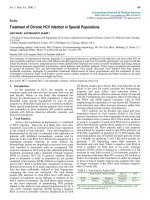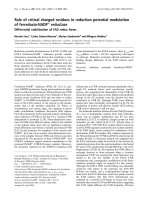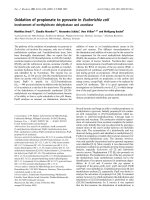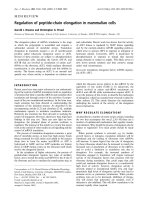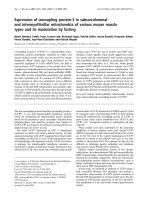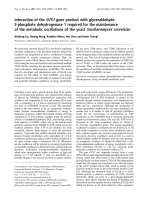Báo cáo y học: "Incidence of multiple Herpesvirus infection in HIV seropositive patients, a big concern for Eastern Indian scenario" ppt
Bạn đang xem bản rút gọn của tài liệu. Xem và tải ngay bản đầy đủ của tài liệu tại đây (577.58 KB, 7 trang )
Chakraborty et al. Virology Journal 2010, 7:147
/>Open Access
RESEARCH
© 2010 Chakraborty et al; licensee BioMed Central Ltd. This is an Open Access article distributed under the terms of the Creative Com-
mons Attribution License ( which permits unrestricted use, distribution, and reproduc-
tion in any medium, provided the original work is properly cited.
Research
Incidence of multiple
Herpesvirus
infection in HIV
seropositive patients, a big concern for Eastern
Indian scenario
Nilanjan Chakraborty*
1
, Sohinee Bhattacharyya
1
, Chandrav De
1
, Anirban Mukherjee
1
, Dwipayan Bhattacharya
2
,
Shantanu Santra
3
, Rathindra N Sarkar
3
, Dipanjan Banerjee
4
, Shubhasish K Guha
5
, Utpal K Datta
3
and
Sekhar Chakrabarti
1
Abstract
Background: Human immunodeficiency virus (HIV) infection is associated with an increased risk for human herpes
viruses (HHVs) and their related diseases and they frequently cause disease deterioration and therapeutic failures.
Methods for limiting the transmission of HHVs require a better understanding of the incidence and infectivity of oral
HHVs in HIV-infected patients. This study was designed to determine the seroprevalence of human herpes viruses
(CMV, HSV 2, EBV-1, VZV) antibodies and to evaluate their association with age, sex as well as other demographic and
behavioral factors.
Results: A study of 200 HIV positive patients from Eastern India attending the Calcutta Medical College Hospital,
Kolkata, West Bengal, Apex Clinic, Calcutta Medical College Hospital and ART Center, School of Tropical Medicine,
Kolkata, West Bengal was done. Serum samples were screened for antibodies to the respective viruses using the
indirect ELISA in triplicates.
CytoMegalo virus (CMV), Herpes Simplex virus type 2 (HSV-2), Varicella Zoster virus (VZV), and Epstein Barr virus (EBV-1) were
detected in 49%, 47%, 32.5%, and 26% respectively.
Conclusion: This study has contributed baseline data and provided insights in viral OI and HIV co-infection in Eastern
India. This would undoubtedly serve as a basis for further studies on this topic.
Background
The HIV/AIDS is a global epidemic and approximately 40
million people are living with HIV/AIDS worldwide [1].
About 95% of all HIV/AIDS infected people are living in
developing countries. It is estimated that India is cur-
rently harboring about 5.134 million HIV infected cases
and comprises of 65% cases of Southeast Asia. The HIV/
AIDS pandemic in India has extended beyond the com-
mon classification of high-risk groups and now is com-
mon among the general population [2,3]. The nation is
indeed at the threshold of an exponential growth of this
epidemic. Opportunistic Infections (OIs) have been rec-
ognized as common complications of HIV infection due
to immune deficiency. OI is the main reason behind hos-
pitalization and substantial morbidity in HIV infected
patients [4]. It necessitates toxic and expensive therapies
and reduces the expected life span of such patients. Virtu-
ally all HIV-related mortality is preceded by opportunis-
tic infection [5]. OIs encompass a wide variety of
microorganisms that produce fulminant infections in
immunocompromised HIV seropositive patients. Viral
pathogens causing OI evoke a spectrum of illness ranging
from asymptomatic to fulminant diseases in HIV-
infected individuals. Since the onset of the acquired
immunodeficiency syndrome (AIDS) epidemic in 1980;
human herpes viruses have resulted in many of the sec-
ondary manifestations of human immunodeficiency virus
(HIV) infection such as Painful rash due to Painful rash
caused by herpes zoster [6,7]. Almost 45 million people
worldwide have been infected with HIV, and prior to
* Correspondence:
1
Virology Department, ICMR Virus Unit, ID & BG Hospital, GB4, 57 Dr. SC
Banerjee Road Beliaghata, Kolkata-700 010, India
Full list of author information is available at the end of the article
Chakraborty et al. Virology Journal 2010, 7:147
/>Page 2 of 7
highly active antiretroviral therapy (HAART), more than
75% of all HIV-infected individuals developed HHV-
related symptoms. The advent of HAART has decreased
the incidence of opportunistic HHV diseases and
improved the survival capacity of those who received the
therapy. Whether HAART has altered the rate of HHV
reemergence from latency or the ability of HHVs to pro-
duce clinical manifestations is not established [8]. Clearly,
HHV-related malignancies remain a significant problem
for the HIV infected patients [9,10]. Cytomegalovirus
(CMV), Herpes Simplex virus 1 & 2 (HSV-1 & 2), Veri-
cella Zoster virus (VZV), Epstein Barr virus (EBV are the
common herpesviruses in Indian subcontinent responsi-
ble for viral OIs in HIV positive populations [11]. These
herpes viruses are usually acquired in childhood or young
adulthood, establish a state of asymptomatic latency, and
may eventually reactivate to give clinical disease later in
life or following an HIV induced decline in cell-mediated
immune control. Herpes simplex virus type 1 (HSV1) and
type 2 (HSV2) cause primary and recurrent oral, genital
and rectal ulceration and occasionally disseminated vis-
ceral and CNS disease [12]. In HIV infected individuals,
re-activation of VZV causes prolonged and severe mani-
festation of herpes zoster [7]. Retinitis is most frequent
clinical manifestation of CMV though other manifesta-
tions like gastrointestinal disease, encephalitis and pneu-
monia may occur.
In India, especially in the eastern part (including West
Bengal), limited information is available on opportunistic
infections among HIV seropositive individuals. The rela-
tive frequencies of specific opportunistic diseases may
vary in different countries and even in different areas
within the same country [[13-15], and [16]]. Early diagno-
sis of opportunistic infections and prompt treatment def-
initely contribute to increased life expectancy among
infected patients delaying the progression to AIDS [17].
In India, quite often the diagnosis of OI is made only on
clinical signs and symptoms or when illness is quite
advanced, and by then it may be polymicrobial in nature
[18,19]. Determining the spectrum of OIs and the chang-
ing pattern over the years, in a given region requires ade-
quate surveillance and good diagnostic services that are
not available in many parts of the country [20]. There is
paucity of reports about nature of etiological agents caus-
ing various clinical manifestations in HIV disease in India
[21,22]. Hence, integrated investigative procedures are
vital, especially in early stages of HIV infection. The clini-
cal manifestations of HIV infection in India (like other
developing countries) are diverse. Spectrum of OIs with
which most of the patients present in the clinics, reflects
a wide variety of other endemic diseases prevalent within
each region.
Thus, the importance of viruses in engendering many
of the secondary opportunistic illnesses (and several of
the tumors) of AIDS warrants a survey of their disease
manifestations and clinical management. Our objective
in this study therefore was to determine the prevalence of
antibodies to opportunistic viral antigens in HIV infected
Indian population. We focused primarily on the four
most prevalent viruses of the herpesviridae family found
in Eastern Indian population [22]. This study is aimed at
providing baseline data on the prevalence of various viral
OIs as part of the preliminary investigation on the
dynamics of viral opportunistic infections in immuno-
compromised population of India. The purposes of this
study were to determine the frequency of the major viral
opportunistic infections in HIV seropositive patients/
AIDS patients from Eastern India and to determine the
risk factors associated with OI at the time of diagnosis
among these patients in order to promote a greater
awareness and management of this modern day "plague"
and its complications.
Materials and methods
Study site and patient recruitment
In our study, we reviewed 200 HIV/AIDS patients, admit-
ted between January 2006 to November 2008 at Calcutta
Medical College Hospital, Kolkata, West Bengal, Apex
Clinic, Calcutta Medical College Hospital- a referral cen-
ter for patients of HIV infection or AIDS, and ART Cen-
ter, School of Tropical Medicine, for the detection of viral
opportunistic infections. Their HIV status was confirmed
by three ERS(Enzyme Linked Immunosorbent Assay
[ELISA], Rapid, Simple), an ELISA(HIV ELISA, Rapid
test)and Western Blot as recommended by the National
Aids Control Organization (NACO), Ministry of Health
and Family Welfare, Government of India. The admitted
patients were referred to us because they presented
symptoms related to HIV infection or symptoms of
unknown origin such as prolonged fever. The study group
comprised of 140 (70%) males and 60 (30%) females, with
mean ages of 36 ± 16 and 35 ± 12 years respectively. The
patients included in the study were from different states
of Eastern India. Our observations included only periods
of hospitalization; we did not investigate patients' records
after their discharge from the hospital. There were 26
males and 5 females in the patient group.
Investigation of risk factors
Written consent was obtained from all the patients and
their complete and relevant demographic information
including age, sex, ethnicity, residential history, education
status, sexual behavior, drug abuse, and other risk factors
was recorded. A medical history was obtained for each
patient, and all patients received a full clinical examina-
tion. The diagnosis of the viral opportunistic infections
was based exclusively on well defined clinical symptoms
and the determination of specific antibodies in serum by
Chakraborty et al. Virology Journal 2010, 7:147
/>Page 3 of 7
ELISA. Data representing the patient groups in various
risk factors as described in Table 1.
This study has been approved by appropriate human
subject's research review board, by the Institutional Ethi-
cal Committee of ICMR Virus Unit, Kolkata, India.
Laboratory examination and diagnosis of viral OIs
The viral OIs were primarily diagnosed by the common
clinical manifestations. For the diagnosis of CMV, the pri-
mary clinical symptoms were pneumonia, retinitis (an
infection of the eyes), blindness and gastrointestinal dis-
ease The common clinical features of CMV disease is
retinitis (which usually presents as painless, gradual loss
of vision, floaters) followed by oesophagitis (presents as
dysphagia - difficulty in swallowing or Odynophagia -
painful swallowing), colitis (presents as pain abdomen,
bloody diarrhea, fever), pneumonitis (cough, breathless-
ness), encephalitis (altered mental status, convulsion,
headache), radiculoneuropathy (weakness/paralysis of
lower limbs, pain lower back, urinary retention) etc. Pri-
mary symptoms of HSV included persistent vesicular and
ulcerative lesions of the oral and anogenital areas, often
with extensive or deep ulcerations and blisters on or
around the genitals or rectum. The blisters left tender
ulcers (sores) that took two to four weeks to heal the first
time they occurred. Other symptoms included tender
tonsils covered with a whitish substance that made swal-
lowing difficult or blisters present in the mouth. Primary
diagnosis of EBV was based on the clinical symptoms of
fever, sore throat and swollen lymph glands. The com-
monest clinical presentation of EBV disease in HIV posi-
tives is Oral hairy Leukoplakia (OHL). VZV was
primarily diagnosed based on the clinical manifestations
of severe headaches, backache, general malaise and fever
accompanied by the typical exanthem (rash) of chicken-
pox. Other symptoms of VZV included painful oral
lesions, vesicular rash, facial numbness and loss of hear-
ing/ear pain. All the clinical manifestations were con-
firmed by ELISA test done in triplicates. The following
diagnostic test kits were used for the assay of the oppor-
tunistic viruses:
Anti- CMV
Serum anti-CMV was determined by a commercially
available test kit, CMV IgM, IgG ELISA Test kit supplied
by EQUIPAR was used to detect antibodies against the
CMV-IE1 and CMV-pp65mII.
Anti - EBV 1
Serum anti-EBV was determined by a commercially avail-
able test kit, EBV IgG, IgM ELISA Test kit supplied by
Virotech/Germany was used to detect antibodies against
the affinity-purified gp125 + p18 Peptide.
Anti- HSV 2
Serum anti- HSVwas determined by a commercially
available test kit, HSV type1 IgM ELISA Test kit supplied
by EQUIPAR was used to detect antibodies against the
affinity-chromatographically purified recombinant anti-
gen HSV-2.
Anti - VZV
Serum anti-VZV was determined by a commercially
available test kit, VZV IgM, IgG, IgA ELISA Test kit sup-
plied by Virotech/Germany was used to detect antibodies
against the Ellen Strain antigen (ATCC).
Evaluation of whole blood CD4+ Lymphocyte count
The CD4+ count of the HIV seropositive patients (n =
200) was done at the discretion of the treating physicians.
The CD4+ T cell percentages and the CD4+ counts were
estimated by FACS Calibur flow cytometer (Becton Dick-
inson, San Jose, Calif., USA). Dual color immunopheno-
typing was performed using standard whole blood
methodology.
Statistical analysis
The data was analyzed by the use of MINITAB Statistical
software version 13.1. A regression model was fitted by
using the data to analyze the effect of co-variates (i.e. age,
sex, mode of infection, CD4+) on different response vari-
able (i.e. different opportunistic infection). The Chi
Square test of independence was used for statistical anal-
ysis and the Null hypothesis (H
0
hypothesis) has also been
tested. A P- value of > 0.05 was regarded as statistically
significant. The mean, median, mode and standard devia-
tion has also been done by using the same software. 95%
Class Intervals and Kramer's V value, a measure of the
Table 1: The HIV-seropositive patient groups in various risk
factors
Risk Behavior Male Female
Blood transfusion 13 6
IVD abuse 25 3
Heterosexual 82 39
Homophiles 20 12
Occupation
Unemployed 12 46
Government Service 13 -
Non Government Service 115 14
Deaths 32
Chakraborty et al. Virology Journal 2010, 7:147
/>Page 4 of 7
strength of association among the levels of the row and
column variables were calculated according to conven-
tional methods. The purpose of the regression model and
Chi Square test is to test the effect of different covariates
on different response variables. Using the P-value
method, one can conclude whether a given covariate has
an effect on the response variable. From our data analysis,
it is clear that age, sex, mode of transmission and CD4+
count (co-variates) have effects on the OIs (response vari-
ables) of our study subjects.
Results
Of the 200 HIV/AIDS patients studied, the samples posi-
tive for CMV, HSV, VZV, and EBV are 98 (49%), 94 (47%)
52 (26%), and 65 (32.5%) respectively. The incidence of
CMV was higher among males than females 59/39. HSV
was also found to be more predominant in the males 63/
31. The incidence of VZV and EBV was also found to be
dominant in the male population, the dominancy being
46/19 and 31/21 respectively.
Age related prevalence of opportunistic viral antibodies
in the serum of 200 HIV infected patient cohorts was
assessed and results showed that individuals in the age
group of 21- 40 years had the highest incidence of viral
opportunistic infections as evident from Table. 2. The
Figure 1 shows the respective opportunistic viral serum
antibody incidence in the three age groups. The antibody
OD with mean 0.275, CI (-0.34715, 0.897152); mean
0.237, CI (-0.373, 0.846336); mean 0.183, CI (-0.2251,
0.591771) mean 0.103, CI (-0.2192, 0.328658) for CMV,
HSV, VZV and EBV respectively.
Assessment of the risk factors associated with HIV
transmission showed opportunistic viral incidence of
HSV, CMV, VZV and EBV in Table. 3. HSV infection is
found to be dominating in the heterosexual individuals
among the study group. There are no significant varia-
tions among the homophiles, the drug users and the
blood transfusion patients.
The incidence of the different viral OIs was also
assessed with respect to the CD4+ cell count/μl of blood
and patients with mean CD4+ cell count of 51-100
showed the highest prevalence of opportunistic viral anti-
bodies. This was followed by the group with CD4+ count
of 101-150, 51-100, 151-200 and >200 (data not shown).
Discussion
Since the start of the epidemic, issues related to HIV/
AIDS have had a high profile in industrialized countries.
However, the burden of the disease continues to fall most
heavily, and often less visibly in developing countries [23].
Viral opportunistic infections and HIV/AIDS having
become so intertwined have constituted a major public
health problem in the country. The opportunistic infec-
tions, therefore, play a major role in clinical presentations
and remain one of the most frequent causes of death in
these patients. However in spite of this, very little infor-
mation on viral opportunistic infections and HIV co-
infection in India is available. A few reports documented
were only on HBV-HIV co-infection [24,25]. Viral oppor-
tunistic infections have not been given their desired
attention in the Indian health care delivery system, largely
due to the dearth of information on the co-infection of
HIV positive population with viral OIs. Our study was
therefore, designed to assess the incidence of HSV, EBV,
CMV, and VZV infections among HIV patients in Eastern
India so as to provide a baseline data on the dynamics of
viral opportunistic infections in the immunocompro-
mised population of Eastern India.
Table 2: The different opportunistic viruses which infects
HIV/AIDS patients of different age groups
Age Groups (in years)
Opportunistic
Viruses
Sex ≤ 20 21-40 41-60
CMV Male 9 37 13
Female 5 26 8
EBV Male - 22 9
Female 2 15 4
HSV Male 9 43 11
Female 4 19 8
VZV Male 9 24 13
Female 2 10 7
Figure 1 Opportunistic viruses and CD4+ count in our patient co-
horts. The range of CD4+ counts/μL of blood are shown in index. The
number of samples positive against the respective Opportunistic virus-
es are shown in bars corresponding to the CD4+ counts in the blood.
0
0.1
0.2
0.3
0.4
0.5
0.6
0.7
0.8
0.9
<20 21-40 41-60
Mean ELISA ODs
Age Range
cmv
EBV 1
HSV2
VZV
Chakraborty et al. Virology Journal 2010, 7:147
/>Page 5 of 7
Infection by cytomegalovirus (CMV) is the major cause
of morbidity and mortality in individuals with depressed
cell mediated immunity of congenital origin, iatrogenic
origin and that associated with acquired immunodefi-
ciency syndrome (AIDS). The clinical diagnosis of AIDS
with CMV infection can be difficult in the absence of
CMV retinitis, polyradiculopathy and the classical CMV
syndrome [26,27]. The diagnosis poses difficulties
because a 2-3 week period is mandatory for virus isola-
tion. While IgM antibodies as detected by ELISA corre-
late poorly with the clinical status of CMV infection and
facilities for culture are usually not available in most cen-
ters [28]. There are a few reports available of CMV infec-
tion in Indian patients with HIV/AIDS, which are based
primarily on clinical or autopsy evaluation [25,29,30]. We
found CMV as the most incidental co infection in HIV/
AIDS patient with the overall incidence of 49%.
Human immunodeficiency virus (HIV) infection is
associated with an increased risk for human herpesvi-
ruses (HHVs) and their related diseases. The incidence of
HSV in human immunodeficiency virus (HIV)-seroposi-
tive patients has not been focused, with reports generally
focusing on individual infection [31]. In this report, the
serum prevalence of HSV is found to be higher in HIV-
seropositive patients; the overall incidence is around 47%.
VZV infection, the overall incidence being 32.5% is the
third most incidental coinfection in HIV seropositive
patients. VZV is one of the common aetiological agents
of viral retinitis. Neurological complications of the reacti-
vation of VZV occur most frequently in elderly persons
and immunocompromised patients [32]. Gray et al.
reported VZV infection of the CNS in more than 4% of
patients with AIDS examined at autopsy. In AIDS
patients, VZV tends to reactivate from multiple dorsal
root ganglia levels, and the disease is often disseminated.
EBV is the least prevalent among the four HHVs stud-
ied in our work which is 26% of the total. EBV has been
identified as a co-factor in the pathogenesis of a signifi-
cant proportion of HIV related lymphoproliferative dis-
orders and in oral hairy leukoplakia [33]. However, only
limited information exists on the status of EBV in the
course of HIV infection and the extent of its interaction
with HIV. There is also growing interest in the biological
properties and pathogenic potential of the different EBV
subtypes, EBV-1 and EBV-2. Serological findings and
studies in saliva and blood have indicated a high inci-
dence of EBV-2 infection in the course of HIV disease,
but there is limited information regarding its significance
[34-37].
The analysis of the association of immunological status
and the presence of viral OIs revealed that the CD4 count
was significantly associated with the presence of viral
OIs. An increasing CD4 count significantly protected
patients from expressing HHVs in our patient cohorts as
indicated by the correlation as in Figure 2. It has been
detected clinically that more frequently virus infections
are associated with the compromised immunity in HIV-
infected patients [38-41]. We found that, HIV-infected
patients with CD4+ cell counts of around 200 cells/mm3
are less likely to be infected with any virus examined here
suggesting that a higherCD4+ cell count does play a role
in immunity against virus infection. This clinical out-
come is consistent with our finding of significantly lower
CD4 cell count in HIV patients with viral OIs, indicating
that the diagnosis of viral opportunistic infections can
indeed be correlated with the clinical manifestation and
thus is helpful in predicting disease progression. Figure 3
clearly shows that the patient group with CD4+ counts
between 51 and 100 cells/μl is most susceptible to viral OI
in HIV/AIDS patient. The groups with CD4+ count less
Table 3: Association of HIV transmission Risk factors with the various Opportunistic Viruses of the patients blood samples
Risk Factors of HIV transmission
Heterosexual Homophile IDU Blood transfusion
Opportunistic Viruses Male Female Male Female Male Female Male Female
CMV 2719138 132 9 3
EBV 2313527- 2-
HSV 43121169373
VZV 199 135 11- 6 2
Chakraborty et al. Virology Journal 2010, 7:147
/>Page 6 of 7
than 50 cells/μl are showing least opportunistic viruses
which could be due to the advanced HAART treatment.
This study is aimed at providing baseline data on viral
opportunistic infections in HIV seropositive population
as part of the preliminary investigation on the dynamics
of viral opportunistic infections in immunocompromised
population of India. One of the major problems is the
lack of specific investigations that can provide rapid and
reliable confirmation of a clinical diagnosis. A high level
of alertness is needed at both clinical and laboratory level
and routine surveillance studies need to be undertaken.
Institutions in India and other developing countries need
to be equipped to face the emerging challenge, in the
form of updating the present knowledge, by way of edu-
cation and training of the personnel, acquisition of skills
of improved procedures, and their implementation in
appropriate settings with adequate administrative sup-
port. Further investigations have to be undertaken with
matched control samples as case control analysis with
respect to all HHV infection in HIV seropositive individ-
uals in Indian perspective.
Competing interests
The authors declare that they have no competing interests.
Authors' contributions
CD and SB have equal contribution to the work. NC conceived and designed
the study. RNS, SS, DB, SKG and UD supplied the samples and did HIV testing.
NC, CD, SB and AM carried out the laboratory investigations. CD, SB and NC
analyzed and interpreted the data and drafted the manuscript. Dw Bh did the
statistical analysis. SC monitored the total project. NC reviewed the manuscript
critically for medical and intellectual content. All authors read and approved
the final manuscript.
Acknowledgements
The authors thank Mr. Probal Kanti Ray and Mr Tapan Chakrabarti for their labo-
ratory help. This work was supported by intramural funds received from Indian
Council of Medical Research, Government of India.
Author Details
1
Virology Department, ICMR Virus Unit, ID & BG Hospital, GB4, 57 Dr. SC
Banerjee Road Beliaghata, Kolkata-700 010, India,
2
Microbiology Division,
National Institute of Cholera and Enteric Diseases P33 CIT Scheme-XM, Kolkata-
700 010, India,
3
Department of Medicine, Calcutta Medical College and
Hospital, 88 College Street, Kolkata-700 073, India,
4
Department of Medicine,
APEX Clinics, Calcutta Medical College and Hospital, 88 College Street, Kolkata
700 073, India and
5
Department of Tropical Medicine, School of Tropical
Medicine, 108 C.R Avenue, Kolkata- 700 073, India
References
1. Quinn TC: Global burden of the HIV pandemic. Lancet 1996, 348:99-105.
2. Ran K, Hemalatha R: Oral lesions in HIV infection in developing
countries: an overview. Advances in Dental Research 2006, 19:63.
3. Solomon S, Solomon S, Ganesh A: AIDS in India. British Medical Journal
2006, 82:545.
4. Brooks JT, Kaplan JE, Holmes KK, Benson C, Pau A, Masur H: HIV-
Associated Opportunistic Infections-Going, Going, But Not Gone: The
Continued Need for Prevention and Treatment Guidelines. Clinical
Infectious Diseases 2009, 48(5):609-611.
Received: 28 January 2010 Accepted: 6 July 2010
Published: 6 July 2010
This artic le is available fro m: http://www.v irologyj.com/co ntent/7/1/147© 2010 Chakraborty et al; licensee BioMed Central Ltd. This is an Open Access article distributed under the terms of the Creative Commons Attribution License ( which permits unrestricted use, distribution, and reproduction in any medium, provided the original work is properly cited.Virology Journal 2010, 7:147
Figure 3 Antibody prevalence of the corresponding viruses in
different age groups of our patients samples.
0
5
10
15
20
25
30
35
40
No. of samples
N = 200
Opportunistic Viruses
less 50
51-100
101-150
151-200
200 or more
Figure 2 CD4+ counts/μL of blood versus the antibody titres against the different opportunistic viruses in the patients. The CD4+ count
ranges between 50/μL to 300/μL and the antibody titres showing the mean OD of the triplicate ELISA reading.
R2 = 0.8962
R² = 0.970
R2 = 0.9703
R² = 0.992
0
0.05
0.1
0.15
0.2
0.25
0.3
0 50 100 150 200 250 300
Mean viral antibody OD
CD4+ count/µL
cmv
EBV
HSV
VZV
Linear (cmv)
Linear (EBV )
Linear (HSV)
Linear (VZV)
Chakraborty et al. Virology Journal 2010, 7:147
/>Page 7 of 7
5. Piscitelli SC, Gallicano KD: Interactions among drugs for HIV and
opportunistic infections. The New England Journal of Medicine 2001,
344(13):984.
6. Gershon AA: Varicella-zoster virus infections. Pediatrics in Review 2008,
29(1):5.
7. Weaver BA: Herpes Zoster Overview: Natural History and Incidence.
JAOA: Journal of the American Osteopathic Association 2009, 109(6
Supplement 2):S2.
8. Jallow S, Alabi A, Sarge-njie R, Peterson K, Whittle H, Corrah T, Jaye A,
Cotton M, Vanham G, Mcconkey SJ: Virological response to Highly Active
Antiretroviral Therapy (HAART) in HIV-2 and HIV-1/HIV-2 Dually
Infected Patients in The Gambia and the Emergence of Drug Resistant
variants. Journal of Clinical Microbiology 2009. doi:10.1128/JCM.01654-08.
9. Pantanowitz L, Schlecht HP, Dezube BJ: The growing problem of non-
AIDS-defining malignancies in HIV. Current Opinion in Oncology 2006,
18(5):469.
10. Mitsuyasu R: Malignancies in HIV: a growing problem. Current Opinion in
Oncology 2007, 19(5):444.
11. Roberts S: Herpes simplex virus: incidence of neonatal herpes simplex
virus, maternal screening, management during pregnancy, and HIV.
Current Opinion in Obstetrics and Gynecology 2009, 21(2):124.
12. Sarna J, Sharma A, Naik E, Toney J, Msrfatia Y: Protean manifestations of
herpes infection in AIDS cases. Indian Journal of Sexually Transmitted
Diseases and AIDS 2009, 29(1):26.
13. Perez Cachaferio S, Del Amo J, Iribarren JA, Salavert Lleti M, Gutierrez F,
Moreno A, Labarga P, Pineda JA, Vidal F, Berenguer J: Decrease in serial
prevalence of coinfection with hepatitis C virus among HIV-infected
patients in Spain, 1997-2006. Clinical Infectious Diseases 2009,
48(10):1467-1470.
14. Bani-Sadr F, Lapidus N, Bedossa P, De Boever CM, Perronne C, Halfon P, Pol
S, Carrat F, Cacoub P: Progression of fibrosis in HIV and hepatitis C virus-
coinfected patients treated with interferon plus ribavirin-based
therapy: analysis of risk factors. Clinical Infectious Diseases 2008,
46(5):768-774.
15. Kaplan JE, Hu DJ, Holmes KK, Jaffe HW, Masur H, De Cock KM: Preventing
opportunistic infections in human immunodeficiency virus-infected
persons: implications for the developing world. American Journal of
Tropical Medicine and Hygine 1996, 55:1-11.
16. Lucas , Sebastian B, Anatole Hounnou, Christopher Peacock, Anne
Beaumel, Gaston Djomand, Jean-Marie N'Gbichi, Kouadio Yeboue, Michel
Hondé, Mohenou Diomande, Christian Giordano, Ronan Doorly, Kari
Brattegaard, Luc Kestens, Ronald Smithwick, Auguste Kadio, Niamkey
Ezani, Achi Yapi, De Cock , Kevin M: The mortality and pathology of HIV
infection in a West African city. AIDS 1993, 7:1569-1579.
17. Singh A, Bairy I, Shivananda PG: Spectrum of opportunistic infections in
AIDS patients. Indian journal of Medical Sciences 2003, 57(1):16-21.
18. Khatter S: Mycobacterial infections in patients seropositive for human
immunodeficiency virus. All India Institute of Medical Sciences, New
Delhi; 1999.
19. Shailaja VV, Pai LA, Mathur DR, Lakshmi V: Prevalence of bacterial and
fungal agents causing lower respiratory tract infection in patients with
human immunodeficiency virus infection. Indian Journal of Medical
Microbiology 2004, 22:28-33.
20. Banerjee U: Progress in diagnosis of opportunistic infections in HIV/
AIDS. Indian Journal of Medical Research 2005, 121:395-406.
21. Miller CS, Berger JR, Mootoor Y, Avdiushko SA, Zhu H, Kryscio RJ: High
prevalence of multiple human herpesviruses in saliva from human
immunodeficiency virus-infected persons in the era of highly active
antiretroviral therapy. Journal of clinical Microbiology 2006, 44(7):2409.
22. Sachithanandham J, Ramamurthy M, Kannangai R, Daniel H, Abraham O,
Rupali P, Pulimood S, Abraham A, Sridharan G: Detection of
opportunistic DNA viral infections by multiplex PCR among HIV
infected individuals receiving care at a tertiary care hospital in South
India. Indian Journal of Medical Microbiology 2009, 27(3):210.
23. Grant AD, De Cock KM: The growing challenge of HIV/AIDS in
developing countries. Br Med Bull 1998, 54:369-381. 30. Halim NKD, Offor
E, Ajayi OI: Epidemiologic study of the seroprevalence of hepatitis-B
surface antigen (HBsAg) and HIV-1 in blood donors. Nigerian Journal of
Clinical Practice 1992, 2: 42-45.
24. Risbud A, Mehendale S, Basu S, Kulkarni S, Walimbe A, Arankalle V,
Gangakhedkar R, Divekar A, Gadkari D, Paranjape R: Prevalence and
incidence of hepatitis B virus infection in STD clinic attendees in Pune,
India. British Medical Journal 2002, 78(3):169.
25. Lanjewar D, Anand B, Genta R, Maheshwari M, Ansari M, Hira S, Dupont H:
Major differences in the spectrum of gastrointestinal infections
associated with AIDS in India versus the west: an autopsy study.
Clinical Infectious Diseases 1996, 23(3):482-485.
26. Eidelberg D, Sotrel A, Vogel H, Walker P, Kleefield J, Crumpacker CS:
Progressive polyradiculopathy in acquired immunedeficiency
syndrome. Neurology 1986, 36:912-6.
27. Wiley CA, Nelson JA: Role of human immunodeficiency virus and
cytomegalovirus in AIDS encephalitis. American Journal of Pathology
1988, 133:73-81.
28. Lazzarotto T, Dal Monte P, Boccuni MC, Ripalti A, Landini MP: Lack of
correlation between virus detection and serologic tests for diagnosis
of active cytomegalo virus infection in patients with AIDS. Journal of
Clinical Microbiology 1992, 30:1027-9.
29. Santosh Vani T, Yasha C, Panda KM, Das S, Satishchandra P, Gourie-Devi M,
Ravi V, Desai A, Khanna N, Chandramuki A, Swamy HS, Nagaraja D, Kolluri
V, Sastry R, Shankar SK: Pathology of AIDS Study from a
Neuropsychiatric Centre from South India. Annual Indian Academical
Neurology 1998, 1:71-82.
30. Lanjewar DN, Shetty CR, Catdare G: Profile of AIDS pathology in India. An
autopsy study. In Recent advance in pathology New Delhi: Jaypee
Brothers Medical Publishers; 1988:183-9.
31. Becker TM, Lee F, Daling JR, Nahmias AJ: Seroprevalence of and risk
factors for antibodies to herpes simplex viruses, hepatitis B, and
hepatitis C among southwestern Hispanic and non-Hispanic white
women. Sexually Transmitted Diseases 1996, 23(2):138.
32. Nebuloni M, Vago L, Boldorini R, Bonetto S, Costanzi G: VZV fulminant
necrotizing encephalitis with concomitant EBV-related lymphoma and
CMV ventriculitis: report of an AIDS case. Journal of Neurovirology 1998,
4(4):457-460.
33. Gustafsson A, Levitsky V, Zou JZ, Frisan T, Dalianis T, Ljungman P, Ringden
O, Winiarski J, Ernberg I, Masucci MG: Epstein-Barr virus (EBV) load in
bone marrow transplant recipients at risk to develop posttransplant
lymphoproliferative disease: prophylactic infusion of EBV-specific
cytotoxic T cells. Blood 2000, 95(3):807.
34. Mcclain KL, Leach CT, Jenson HB, Joshi VV, Pollock BH, Parmley RT, Dicarlo
FJ, Chadwick EG, Murphy SB: Association of Epstein-Barr virus with
leiomyosarcomas in young people with AIDS. The New England Journal
of Medicine 1995, 332(1):12.
35. Sixbey J, Shirley P, Chesney P, Buntin D, Resnick L: Detection of a second
widespread strain of Epstein-Barr virus. Lancet 1989, ii:761-765.
36. Sculley T, Cros S, Borrow P, Cooper D: Prevalence of antibodies to
Epstein-Barr virus nuclear antigen 2B in persons infected with the
human immunodeficiency virus. Journal of Infectious Disease 1988,
158:186-192.
37. Kyaw MT, Hurren L, Evans L, Moss DJ, Cooper DA, Benson E, Esmore D,
Sculley TB: Expression of B-type Epstein-Barr virus in HIV-infected
patients and cardiac transplant recipients. AIDS Research and Human
Retroviruses 1992, 8:1869-1874.
38. Smith DK, Neal JJ, Holmberg SD: Unexplained opportunistic infections
and CD4 T-lymphocytopenia without HIV infection an investigation of
cases in the United States. The New England Journal of Medicine
328(6):373.
39. Orenstein JM, Fox C, Wahl SM: Macrophages as a source of HIV during
opportunistic infections. Science 1997, 276(5320):1857.
40. Shieh B, Chang MJ, Ko WC, Chen EJ, Wu JC, Lee CF, Chang TT, Li C: Effects
of Multiple Virus Coinfections on Disease Progression in HIV-Positive
Patients. Intervirology 2003, 46:105-113.
41. Gray F, Belec L, Lescs M, Chretien F, Ciardi A, Hassine D, Flament-Saillour M,
Truchis P, Clair B, Scaravilli F: Varicella-zoster virus infection of the central
nervous system in the acquired immune deficiency syndrome. Brain
1994, 117(5):987.
doi: 10.1186/1743-422X-7-147
Cite this article as: Chakraborty et al., Incidence of multiple Herpesvirus
infection in HIV seropositive patients, a big concern for Eastern Indian sce-
nario Virology Journal 2010, 7:1471
